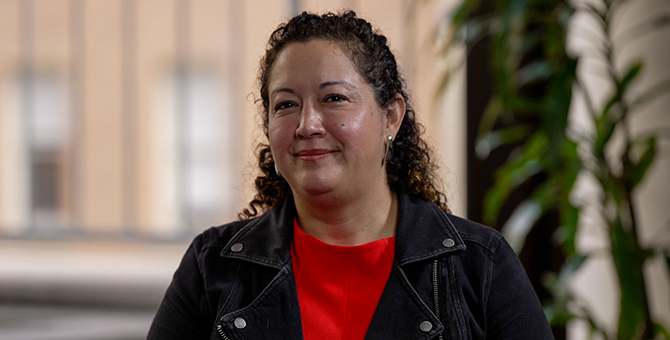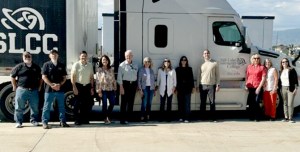The San Francisco Fed recently sat down with Silvia Castro, a business leader in Salt Lake City and a member of the SF Fed’s Community Advisory Council (CAC). In her conversation with Tracy Choi, senior community development outreach manager, and Becky Potts, vice president and regional executive of the Salt Lake City branch, Silvia discussed her experience to date as a CAC member, the work that she does as president and CEO of the Suazo Business Center to serve minority-owned small businesses, and Suazo’s recent designation as a Community Development Financial Institution (CDFI). Watch their conversation below.
Transcript
Becky Potts:
Well, good morning. My name is Becky Potts, and I’m the vice president and regional executive for the Federal Reserve Bank of San Francisco, the Salt Lake City branch. And today I’m with my colleague Tracy Choi. And also we’re here with Silvia Castro, who’s the CEO of the Suazo Business Center and very excited to be with you all today.
I wanted to talk a little bit about the Community Advisory Council, and I know that you’re a big part of that council. Can you share a bit about what we actually do at the Community Advisory Council, and what role you play, with the Federal Reserve Bank?
Silvia Castro:
Definitely. Well, thank you for having me.
I’ve been part of the Community Advisory Council now for a couple of years, and it has been an incredibly exciting time. The focus of the council really is more on underserved communities, communities that usually don’t have access to capital, are usually not involved or are the last ones to kind of feel the economic impact in a positive way. So it’s kind of nice to be part of a group of amazing nonprofits across this region, and it has been a fantastic experience getting to learn from different nonprofits from basically across the Western region.
And that’s what’s fascinating because coming from Utah, I know what’s happening in Utah. And hearing from somebody from Idaho, from Oregon, from Washington State and you’re like, ‘you’re seeing the same thing?’ That’s interesting. Or if there’s something slightly different, it’s also interesting to hear things that are going on in California. California, to me, is a bit ahead because of its population, and they have tried so many different things. So it’s fascinating to hear what they have learned in terms of loan products, in terms of some of the community work. So it’s just a fascinating group.
I knew on a factual, almost academic basis, what the Federal Reserve did. I never attached people to it. You know about the levers of the economy, you know about the interest rates, you know about the money supply. But one of the most fascinating things was actually the involvement of the people, and how deeply caring they were.
It was also getting into the grassroots of nonprofits, getting into the grassroots of what is actually happening in community work. Because, frankly, some of these populations usually are not part of the data. They don’t like to talk to people.
This is where nonprofits are powerful. Nonprofits usually know what’s happening at that grassroots level because people in distressed communities, underserved, they don’t have any kind of trust of the government. So nonprofits are an incredible vehicle to be able to get to the heart of it.
Becky:
How do you feel about the Federal Reserve Bank? Do you feel that we’re actually community-engaged? And, if somebody else in the community was approached to be on the Community Advisory Council, what would you say to them?
Silvia:
I think that was one of the things that was a little bit kind of eye-opening for me is how community-engaged the Federal Reserve is. And sometimes things are done so quietly that people don’t really appreciate or understand what’s really happening and how actually involved they are. I think the [community] engagement has been incredible.
I would say to anyone that would be approached to be part of the Community Advisory Council, do it! It’s an incredible experience. I mean, frankly, not just to be able to give voice and understanding to the Fed in terms what’s happened economically, but also, I think in terms of just professional development, in terms of just networking alone would be also an incredible experience.
Becky:
Great! So now I want to pass some time over to Tracy.
Tracy Choi:
Thanks, Becky! Well, Silvia, it’s so great to hear your experience and your story about serving as a CAC member. I’d love for you to share with us a little bit more about what you all do at the Suazo Business Center. Can you just share a little bit about your work and then maybe also to dive into some unique challenges that your, that the communities you serve face right now?
Silvia:
So the nonprofit I serve on is called the Suazo Business Center. We’ve actually been in the Utah community for 20 years.
Our work really it’s, we’re a fascinating nonprofit because sometimes the way we describe it is, our focus is to ensure people make more money. So we want people to be able to walk up the economic ladder with support, with education, with mentoring. So we provide a venue for them to start up a business, to be able to understand will it make money, will it not make money?
Also, there’s some times that we work with a lot of immigrants, and in that case, frankly, we’re not teaching them how to be an entrepreneur. We’re teaching them how the system works. You know, accounting, taxes, things can be, like, slightly different. So we teach them a little bit of, kind of, best practices, compliance, paperwork to ensure that they start with the right foot forward.
Once they start, I always say the fun part is to start a business, it gets difficult when you’re trying to stay in business. The only constant, frankly, is the changes. The changes that keep happening in the economy, in the… in people. I think the way you market today is so different than the way you market last year, and two years ago.
So we also look at one of the biggest needs when it comes to the minority communities: capital. And that was the reason that we were starting and had to be a Community Development Financial Institution. In Utah, what’s fascinating is there’s really not that many CDFIs. With us getting approved, we’re the sixth one in the state and only the second one to focus on small business. There’s only two in the whole state of Utah that focus on small businesses, which is very small, especially for the need.
Tracy:
So, Silvia, you already shared with us that you’ve achieved a CDFI status, or what’s known as a Community Development Financial Institution. And you already shared with us kind of what you’re able to do now with the CDFI status, but for those folks who may not know what is a CDFI is, can you share a little bit about what they are and why they’re important to the lending ecosystem?
Silvia:
Right. So CDFI stands for Community Development Financial Institution, and it’s a status given by the US Treasury Department. The goal of the CDFI is to basically increase access to capital. That’s really it.
So the way they do it is they work with nonprofits, with financial institutions, for profit and nonprofit, whose focus really is to get that capital into distressed communities.
So when I mentioned that we are a CDFI focusing on small business loans, there are also CDFIs that focus on residential loans. Residential loans in terms of getting a home, in terms of improving a home, or also there’s some that do consumer lending.
It’s really capital. So it’s money to be able to get it back into communities that usually don’t get it. So I mean they’re hugely essential because, I mean, I can tell you from the business aspect for our clients to be able to have that type of access to capital means sometimes whether or not that business is going to make it or not, whether they get to hire a person or not.
This capital allows for job creation, for job stability, for family stability, because capital is everything. It’s able to provide equipment, provide sometimes the funds for cash flow. It’s what allows people to really take that business and make it about wealth creation. Not only are they providing income for that family, but now it’s providing income for that community. So that’s kind of the huge difference when it comes to that.
Tracy:
That’s really exciting for you all to kind of fit that or meet that need in your community in that way. What are you excited about now that you’ve become a CDFI? What are you looking forward to as an organization? What type of work or programs are you looking to expand in the future?
Silvia:
The way we were accepted is we’re actually a minority-focused CDFI, a Latino-focused CDFI. So a vast majority of our loans have to actually be a part of that community.
So I think what gets me really excited is, first, locally in Utah, what we noticed is there’s this niche that is just not being done well. And it’s this niche that private companies are not touching, but it makes a huge difference.
And it’s basically the first $50,000. The first $50,000, is kind of the nice introduction for somebody to become a business borrower. And most business lending, if you go to a bank, if you go to even a credit union, most of the really good loans start at $50k.
Under $50k it’s this interesting, it’s this interesting niche, especially for a company that’s in the first few years, because in the first few years it’s all about the individual. They don’t look at your company, they look at you. And as you’re building something, you might have taken a risk yourself, so this is where this kind of area becomes a little bit of a No Man’s Land.
What’s interesting is we have seen this also with government agencies. So we have a couple of cities in Utah that also do loan funding. And they came to us as a nonprofit, and said, “could you do this because we can’t do this, we don’t know how to do this.”
Because frankly, anything under $50,000 just doesn’t make economic sense for them, because the paperwork is the paperwork, the process is the process, whether they do $50k, $250k or $1 million, right? So this $50,000 threshold wasn’t enough for them to make it economically viable. It wasn’t making enough revenue for them, but it makes a huge difference in the market.
So that was one of the first things that we’re excited about is that we’ll be able to provide these $50,000.
Tracy:
For those who may be seeking to become a CDFI, and I know kind of the window is a little closed for now, but for those who might be seeking to become a CDFI, what advice would you give them? What was some lessons learned through your experience?
Silvia:
So actually, to me, if you’re thinking about becoming a CDFI, this two-year window is perfect. Because frankly, I think it takes a little bit of time for you to get your stuff up and going.
One of the things we did is, frankly, we looked for mentors. We approached other CDFIs in other states. We visited some. We took trips to see their operations. One of the things that was fantastic is how open they were, they thought it was exciting to have more in the state of Utah. So we actually spent time with one in Montana.
So, I think, if I was to become one, I would just take this time to, number one, talk to a bunch of them and kind of figure out, for a lack of a better description, of what’s going to be your flavor. There are so many CDFIs. I would look at what are your current operations. Does it make sense for you?
Like, for us, it was a no-brainer to be about small businesses because we have worked with small businesses for 20 years. We have done the education, the technical assistance, the wrap around. So for us, it was a perfect extension for current programming to add this capital pillar to it. Right?
But if you are a nonprofit that works mostly with individuals, then I think it makes more sense that maybe consumer lending applies to you, or maybe access to homes applies to you. And I think I would take this time right now to figure out which one makes sense, what do they do well, what kind of loan products can you do?
So my advice would be, frankly, if you can do it, do it; the access to capital is so needed in all of our communities. It’s so needed, but you also want to ensure that you do it right, and you use the time wisely in terms of what does the community need, what is a natural extension of your mission in terms of the lending capacity, and then ensuring that you have the systems in place to take advantage of it.
Tracy:
You’re already kind of touching on the larger kind of economic conditions and system. I know you serve a lot of minority-owned entrepreneurs and businesses, and a large portion of them are also Latinos. Could you share with us about what are the Latino contributions to the local Utah economy?
Silvia:
I love that we get to track our outputs. So in terms of what we do as a nonprofit and then we can see that output in terms of what the minority community does for the state.
So we get to create probably an average of about 300 new businesses every year. Then we get to work with existing businesses. So this is kind of the incubation space, that we get to grow them, we get to see them, kind of take them to another level. And we see about 800 to 900 of those businesses in addition to the ones we created. And we get to see this, like I mentioned, throughout the state.
So it’s fascinating because we also see the minority community. Utah itself is about 20% as far as minorities. I know the census is smaller, but minorities are not really good about applying for the census, so we estimate it’s about 20% in Utah. And out of the 20%, about 90% to 95% is Latino.
So a big chunk of it come to us. We’re incredibly unique in that we’re Latino serving. So from the moment you walk into the door, somebody looks like you. So in terms of that, we also get to see the job creation. So the job creation, we get to see about probably about a thousand new jobs created or retained.
Now, the fun part is we also do track sales revenue. So we have seen that start from like $7 million to now we’re starting to see it into like the $50 million range, right?
And it’s interesting because whenever Hispanic Heritage Month comes around, it’s like all the data comes back around and people can see the huge impact when it comes to the economic impact, when it comes to minorities.
And that impact is growing mainly because, like, just in Utah alone, even though I told you it was 20% of the population, if you look at the past ten years, 50% of that growth in population, in the past 10 years, 50—half of it—came from minorities. So imagine what the next ten years are going to be like.
So when it comes to economic power, I mean, that’s just jobs and self-revenue alone. When it comes to economic power, then you get into also buying goods, purchasing goods, and then the amounts keep increasing.
So I think one of the things that doesn’t get told enough is the resiliency factor of this minority community. The resiliency in terms of taking businesses that are used to risk and are used to change, and the resiliency factor in terms of economics.
When you have resilient people in the economy, it makes things more stable. Just like what we see with women-owned and minority-owned that tend to also supply jobs to the whole community. So they’re huge part of that community and that’s also a huge part of that stability and economic growth in that area. And that’s where I think between that and that resiliency power, it’s something that can’t quite be measured now, but it will be measured later.
And the other thing that I love is seeing their kids. So they, our clients’ kids, do so well because their parents are supported. So, especially when it comes to the minority communities, if the parents are supported, the kids do better. So it’s generational.
We noticed that the kids of our clients tend to go for higher education, they have that access to higher education. They have access to a lot more opportunities. And also, I think there’s something about seeing your parents as entrepreneurs that get you to this interesting level, that you navigate business better, because you have seen your parents do that.
And sometimes parents worry about how they spend all this time in the business, yes, but your kid’s watching and learning from you, and it’s lessons that they’re not going to get at school. How you handle a vendor, how you handle troubles. Talking, talking financials, talking money, makes a huge difference.
Tracy:
I think what you just shared is just so moving and meaningful because those types of stories aren’t captured in data. But you’re seeing that given your role in the community.
And so, thank you so much for sharing with us your story. Thanks for serving as our CAC member. We’re so excited for your continued participation on our council and we’re so excited to see what more Suazo will do for the Utah community.
Silvia:
Thank you.
The views expressed here do not necessarily reflect the views of the management of the Federal Reserve Bank of San Francisco or of the Board of Governors of the Federal Reserve System.



